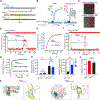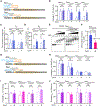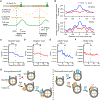Nonreciprocal and Conditional Cooperativity Directs the Pioneer Activity of Pluripotency Transcription Factors
- PMID: 31484078
- PMCID: PMC6750763
- DOI: 10.1016/j.celrep.2019.07.103
Nonreciprocal and Conditional Cooperativity Directs the Pioneer Activity of Pluripotency Transcription Factors
Abstract
Cooperative binding of transcription factors (TFs) to chromatin orchestrates gene expression programming and cell fate specification. However, the biophysical principles of TF cooperativity remain incompletely understood. Here we use single-molecule fluorescence microscopy to study the partnership between Sox2 and Oct4, two core members of the pluripotency gene regulatory network. We find that the ability of Sox2 to target DNA inside nucleosomes is strongly affected by the translational and rotational positioning of its binding motif. In contrast, Oct4 can access nucleosomal sites with equal capacities. Furthermore, the Sox2-Oct4 pair displays nonreciprocal cooperativity, with Oct4 modulating interaction of Sox2 with the nucleosome but not vice versa. Such cooperativity is conditional upon the composite motif's residing at specific nucleosomal locations. These results reveal that pioneer factors possess distinct chromatin-binding properties and suggest that the same set of TFs can differentially regulate gene activities on the basis of their motif positions in the nucleosomal context.
Keywords: Oct4; Sox2; cooperative binding; gene regulatory network; nucleosome; pioneer activity; single-molecule fluorescence; transcription factor.
Copyright © 2019 The Author(s). Published by Elsevier Inc. All rights reserved.
Figures







Similar articles
-
Nucleosome allostery in pioneer transcription factor binding.Proc Natl Acad Sci U S A. 2020 Aug 25;117(34):20586-20596. doi: 10.1073/pnas.2005500117. Epub 2020 Aug 10. Proc Natl Acad Sci U S A. 2020. PMID: 32778600 Free PMC article.
-
Histone modifications regulate pioneer transcription factor cooperativity.Nature. 2023 Jul;619(7969):378-384. doi: 10.1038/s41586-023-06112-6. Epub 2023 May 24. Nature. 2023. PMID: 37225990 Free PMC article.
-
Structural Plasticity of Pioneer Factor Sox2 and DNA Bendability Modulate Nucleosome Engagement and Sox2-Oct4 Synergism.J Mol Biol. 2023 Jan 30;435(2):167916. doi: 10.1016/j.jmb.2022.167916. Epub 2022 Dec 7. J Mol Biol. 2023. PMID: 36495920 Free PMC article.
-
The transcriptional foundation of pluripotency.Development. 2009 Jul;136(14):2311-22. doi: 10.1242/dev.024398. Development. 2009. PMID: 19542351 Free PMC article. Review.
-
Concise review: The Sox2-Oct4 connection: critical players in a much larger interdependent network integrated at multiple levels.Stem Cells. 2013 Jun;31(6):1033-9. doi: 10.1002/stem.1352. Stem Cells. 2013. PMID: 23401375 Free PMC article. Review.
Cited by
-
Pioneer factors: roles and their regulation in development.Trends Genet. 2024 Feb;40(2):134-148. doi: 10.1016/j.tig.2023.10.007. Epub 2023 Nov 7. Trends Genet. 2024. PMID: 37940484 Free PMC article. Review.
-
Chromatin information content landscapes inform transcription factor and DNA interactions.Nat Commun. 2021 Feb 26;12(1):1307. doi: 10.1038/s41467-021-21534-4. Nat Commun. 2021. PMID: 33637709 Free PMC article.
-
Origin recognition complex harbors an intrinsic nucleosome remodeling activity.Proc Natl Acad Sci U S A. 2022 Oct 18;119(42):e2211568119. doi: 10.1073/pnas.2211568119. Epub 2022 Oct 10. Proc Natl Acad Sci U S A. 2022. PMID: 36215487 Free PMC article.
-
Dynamic regulation of chromatin accessibility by pluripotency transcription factors across the cell cycle.Elife. 2019 Dec 3;8:e50087. doi: 10.7554/eLife.50087. Elife. 2019. PMID: 31794382 Free PMC article.
-
Structures and consequences of pioneer factor binding to nucleosomes.Curr Opin Struct Biol. 2022 Aug;75:102425. doi: 10.1016/j.sbi.2022.102425. Epub 2022 Jul 18. Curr Opin Struct Biol. 2022. PMID: 35863165 Free PMC article. Review.
References
Publication types
MeSH terms
Substances
Grants and funding
LinkOut - more resources
Full Text Sources
Research Materials
Miscellaneous

